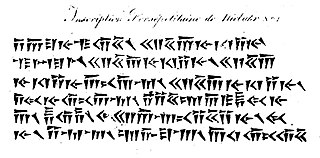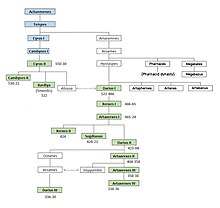
Xerxes I was a Persian ruler who served as the fourth King of Kings of the Achaemenid Empire, reigning from 486 BC until his assassination in 465 BC. He was the son of Darius the Great and Atossa, a daughter of Cyrus the Great. In Western history, Xerxes is best known for his invasion of Greece in 480 BC, which ended in Persian defeat.

Darius I, commonly known as Darius the Great, was a Persian ruler who served as the third King of Kings of the Achaemenid Empire, reigning from 522 BCE until his death in 486 BCE. He ruled the empire at its territorial peak, when it included much of Western Asia, parts of the Balkans and the Caucasus, most of the Black Sea's coastal regions, Central Asia, the Indus Valley in the far east, and portions of North Africa and Northeast Africa including Egypt (Mudrâya), eastern Libya, and coastal Sudan.

Artaxerxes I was the fifth King of Kings of the Achaemenid Empire, from 465 to December 424 BC. He was the third son of Xerxes I.
Mardonius was a leading Persian military commander during the Persian Wars with Greece in the early 5th century BC who died at the Battle of Plataea.
Gobryas was a common name of several Persian noblemen.

In the writings of the Ancient Greek chronicler Herodotus, the phrase earth and water is used to represent the demand by the Persian Empire of formal tribute from the cities or people who surrendered to them.

Megabazus, son of Megabates, was a highly regarded Persian general under Darius, to whom he was a first-degree cousin. Most of the information about Megabazus comes from The Histories by Herodotus.
The Battle of Opis was the last major military engagement between the Achaemenid Persian Empire and the Neo-Babylonian Empire, which took place in September 539 BC, during the Persian invasion of Mesopotamia. At the time, Babylonia was the last major power in Western Asia that was not yet under Persian control. The battle was fought in or near the strategic riverside city of Opis, located north of the capital city of Babylon in modern-day Iraq, and resulted in a decisive victory for Persia. Shortly afterwards, the Babylonian city of Sippar surrendered to Persian forces, who then supposedly entered Babylon without facing any further resistance. The Persian king Cyrus the Great was subsequently proclaimed as the king of Babylonia and its subject territories, thus ending its independence and incorporating the entirety of the fallen Neo-Babylonian Empire into the greater Achaemenid Empire.

Cassandane or Cassandana was a Persian Achaemenian shahbanu and the dearly loved wife of Cyrus the Great.

Aspathines was a senior official under Darius the Great and Xerxes I of Persia.

Hystaspes or Guštāsp, was a Persian satrap of Bactria and Persis. He was the father of Darius I, emperor of the Achaemenid Empire, and Artabanus, who was a trusted advisor to both his brother Darius as well as Darius's son and successor, Xerxes I.

The Achaemenid Empire or Achaemenian Empire was the ancient Iranian empire founded by Cyrus the Great of the Achaemenid dynasty in 550 BC, also known as the First Persian Empire. Based in Western Asia, it was the largest empire the world had ever seen at its time, spanning a total of 5.5 million square kilometres from the Balkans and Egypt in the west to Central Asia and the Indus Valley in the east.

The Achaemenid conquest of the Indus Valley refers to a process beginning in the 6th century BCE and ending in the 4th century BCE, whereby the Achaemenid Persian Empire established control over the northwestern regions of the Indian subcontinent, today predominantly comprising the territory of Pakistan. The first of the two main invasions was conducted around 535 BCE by Cyrus the Great, who annexed the areas to the west of the Indus River, consolidating the early eastern border of the Achaemenid Empire. With a brief pause after Cyrus' death, the campaign continued under Darius the Great, who began to re-conquer former provinces and further expand Persia's political boundaries. Around 518 BCE, Persian armies under Darius crossed the Himalayas into India to initiate a second period of conquest by annexing regions up to the Jhelum River in Punjab.

Doriscus was a settlement in ancient Thrace, on the northern shores of Aegean Sea, in a plain west of the river Hebrus. It was notable for remaining in Persian hands for many years after the Second Persian invasion of Greece, and remained thus known as the last Persian stronghold in Europe.

The Xerxes I inscription at Van, also known as the XV Achaemenid royal inscription, is a trilingual cuneiform inscription of the Achaemenid King Xerxes I. It is located on the southern slope of a mountain adjacent to the Van Fortress, near Lake Van in present-day Turkey. When inscribed it was located in the Achaemenid province of Armenia. The inscription is inscribed on a smoothed section of the rock face near the fortress, approximately 20 metres above the ground. The niche was originally carved out by Xerxes' father, King Darius, but he left the surface blank.

Artyphius was a general of the Achaemenid Army during the Second Persian invasion of Greece. He was the son of Artabanus, grandson of Hystaspes, and therefore nephew of Darius the Great and first degree cousin of Xerxes I.
Mascames, also spelled Maskames was a Persian official and military commander, who flourished during the reign of Xerxes I. He was the son of Megadostes, and was appointed governor of Doriscus in 480 BC by Xerxes I, succeeding the governor who had been appointed by Darius the Great. According to Herodotus, Mascames resisted all Greek attacks following the Second Persian invasion of Greece, and remained thus known as the only remaining Persian governor in Europe. Though the Greeks managed to clear other Persian garrisons in Europe, such as Eion, they were unable to take Doriscus from Mascames, which irked the Athenian military.

Boges was a Persian official and military commander, who functioned as governor (hyparchos) of Eion in Thrace under the King of Kings Xerxes I. According to Herodotus, following the Persian defeats at Plataea and Mycale, Boges refused to abandon Eion when it was besieged by the Athenians and Cimon in 476/5. When he perhaps could have surrendered the town and marched out safely, Boges decided to endure till the end, as he wished not to suffer the ignominy of falling into the enemy’s hands. When the provisions of Eion had finally run out during the protracted siege, Boges built a large fire, killed his wife, children, concubines and servants, and threw them into the fire. He then reportedly collected all pieces of silver and gold that were stored in Eion and threw them into the river Strymon. He then threw himself onto the fire. Boges was highly honored by Xerxes I for his valiance and loyalty, and even Herodotus himself concurred. When Herodotus wrote his Histories in the second half of the fifth century BC, Boges was still praised by the Persians for his deeds. The children of Boges who survived within the Achaemenid Empire were also greatly honoured by Xerxes I.
Arsamenes was a prince of ancient Persia, the son of Darius the Great. We know very little about him today other than that he was, according to the historian Herodotus, the commander of the Utians and Mycae people in the army of Xerxes I during the Second Persian invasion of Greece.
The Utians or Utii were ancient western Iranic nomadic camel-driving people, known to us primarily through the writings of the ancient Greek historian Herodotus. Herodotus describes them as "dressed in skin with the hair on".















